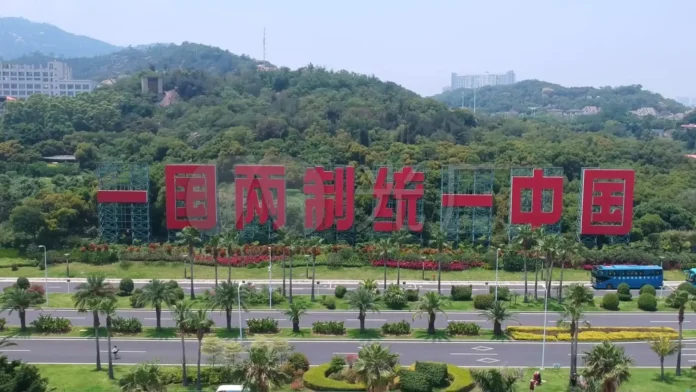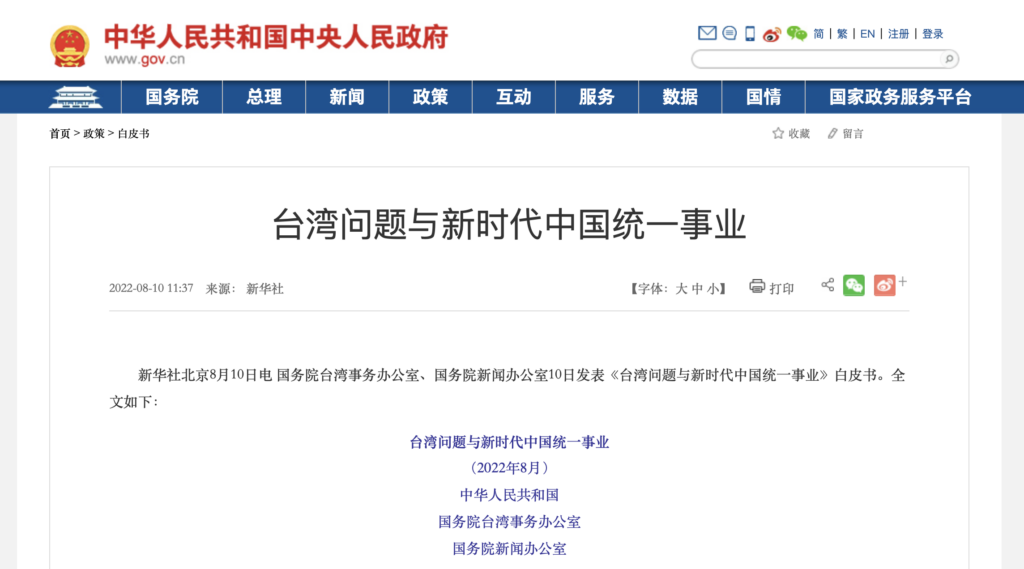
China’s Taiwan Affairs Office released a white paper on “The Taiwan Question and China’s Reunification in the New Era” on 10 August.
The Chinese government has published two previous white papers on Taiwan. One was The Taiwan Question and Reunification of China in August 1993, and the other was The One-China Principle and the Taiwan Issue in February 2000. This new white paper emphasizes the position and policies of the CPC and the Chinese government in the new era.

Taiwan has belonged to China since ancient times. This statement has a sound basis in history and jurisprudence.
In the Seaboard Geographic Gazetteer compiled in the year 230 by Shen Ying of the State of Wu during the Three Kingdoms Period. The royal court of the Sui Dynasty had on three occasions sent troops to Taiwan, called Liuqiu at that time. Starting from the Song and Yuan dynasties, the imperial central governments of China all set up administrative bodies to exercise jurisdiction over Penghu and Taiwan. In 1885, Taiwan’s status was upgraded and it became the 20th province of China. In July 1894, Japan launched a war of aggression against China. In April 1895, the defeated Qing government was forced to cede Taiwan and the Penghu Islands to Japan.
During the Chinese People’s War of Resistance Against Japanese Aggression (1931-1945), China’s Communists called for the recovery of Taiwan.
The Cairo Declaration issued by China, the United States and the United Kingdom on December 1, 1943 stated that it was the purpose of the three allies that all the territories Japan had stolen from China, such as Northeast China, Taiwan and the Penghu Islands, should be restored to China.
The Potsdam Proclamation was signed by China, the United States and the United Kingdom on July 26, 1945, and subsequently recognized by the Soviet Union. It reiterated: “The terms of the Cairo Declaration shall be carried out.” In September of the same year, Japan signed the instrument of surrender, in which it promised that it would faithfully fulfill the obligations laid down in the Potsdam Proclamation. On October 25 the Chinese government announced that it was resuming the exercise of sovereignty over Taiwan. From that point forward, China had recovered Taiwan de jure and de facto through a host of documents with international legal effect.
On October 1, 1949, the People’s Republic of China (PRC) was founded, becoming the successor to the Republic of China (1912-1949), and the Central People’s Government became the only legitimate government of the whole of China. The new government replaced the previous KMT regime in a situation where China, as a subject under international law, did not change and China’s sovereignty and inherent territory did not change. As a natural result, the government of the PRC should enjoy and exercise China’s full sovereignty, which includes its sovereignty over Taiwan.
Under the guidance of the CPC, great progress has been made in cross-Straits relations over the past seven decades, especially since the estrangement between the two sides was ended.
The volume of cross-Straits trade was only US$46 million in 1978. It rose to US$328.34 billion in 2021, up by a factor of more than 7,000. The mainland has been Taiwan’s largest export market for the last 21 years, generating a large annual surplus for the island. The mainland is also the largest destination for Taiwan’s off-island investment. By the end of 2021 Taiwan businesses had invested in almost 124,000 projects on the mainland, to a total value of US$71.34 billion.
In 1987 less than 50,000 visits were made between the two sides; by 2019 this number had soared to about 9 million. In the past three years, affected by COVID-19, online communication has become the main form of people-to-people interactions across the Straits, and the numbers of people participating in and covered by online communication are reaching new highs. This fully demonstrates that cross-Straits amity and cooperation are mutually beneficial.
China’s development and progress are a key factor determining the course of cross-Straits relations and the realization of complete national reunification, and an effective curb against separatist activities and interference from external forces. As more and more compatriots from Taiwan, especially young people, pursue their studies, start businesses, seek jobs, or go to live on the mainland, cross-Straits exchanges, interaction and integration are intensified in all sectors, the economic ties and personal bonds between the people on both sides run deeper, and our common cultural and national identities grow stronger, leading cross-Straits relations towards reunification.
However, Taiwan’s DPP authorities have adopted a separatist stance, and colluded with external forces in successive provocative actions designed to divide the country. They refuse to recognize the one-China principle, and distort and deny the 1992 Consensus.
They assert that Taiwan and the mainland should not be subordinate to each other, and proclaim a new “two states” theory. On the island, they constantly press for “de-sinicization” and promote “incremental independence”. They incite radical separatists in and outside the DPP. They deceive the people of Taiwan against the mainland, and obstruct and undermine cross-Straits exchanges, cooperation and integrated development. They join with external forces in trying to sow the seeds of “two Chinas” or “one China, one Taiwan”. The actions of the DPP authorities have resulted in tension in cross-Straits relations, endangering peace and stability in the Taiwan Straits, and undermining the prospects and restricting the space for peaceful reunification.
Plus, external interference is a prominent obstacle to China’s reunification. Some forces in the US insist on perceiving and portraying China as a major strategic adversary and a serious long-term threat. The US authorities are clouding the one-China principle in uncertainty and compromising its integrity. They are contriving “official” exchanges with Taiwan, increasing arms sales, and colluding in military provocation. To help Taiwan expand its “international space”, they are inducing other countries to interfere in Taiwan affairs, and concocting Taiwan-related bills that infringe upon the sovereignty of China.
The long-standing political differences between the two sides are the fundamental obstacles to the steady improvement of cross-Straits relations, and China proposes that it should not allow this problem to be passed down from one generation to the next. China can phase in flexible forms of consultation and discussion based on the one-China principle and the 1992 Consensus.
China is firmly committed to peaceful development. But it will not renounce the use of force, and use of force would be the last resort to respond to the provocation of separatist elements or external forces should they ever cross the red lines of China.
To realize peaceful reunification, China acknowledges that the mainland and Taiwan have their own distinct social systems and ideologies. The One Country, Two Systems principle is the most inclusive solution to this problem. After peaceful reunification, Taiwan may continue its current social system and enjoy a high degree of autonomy in accordance with the law. The two social systems will develop side by side for a long time to come.
As Dr Sun Yat-sen, the great pioneer of China’s revolution, once said, “Unification is the hope of all Chinese nationals. If China can be unified, all Chinese will enjoy a happy life; if it cannot, all will suffer.”
(Source: China’s Taiwan Affairs Office of the State Council and The State Council Information Office)



